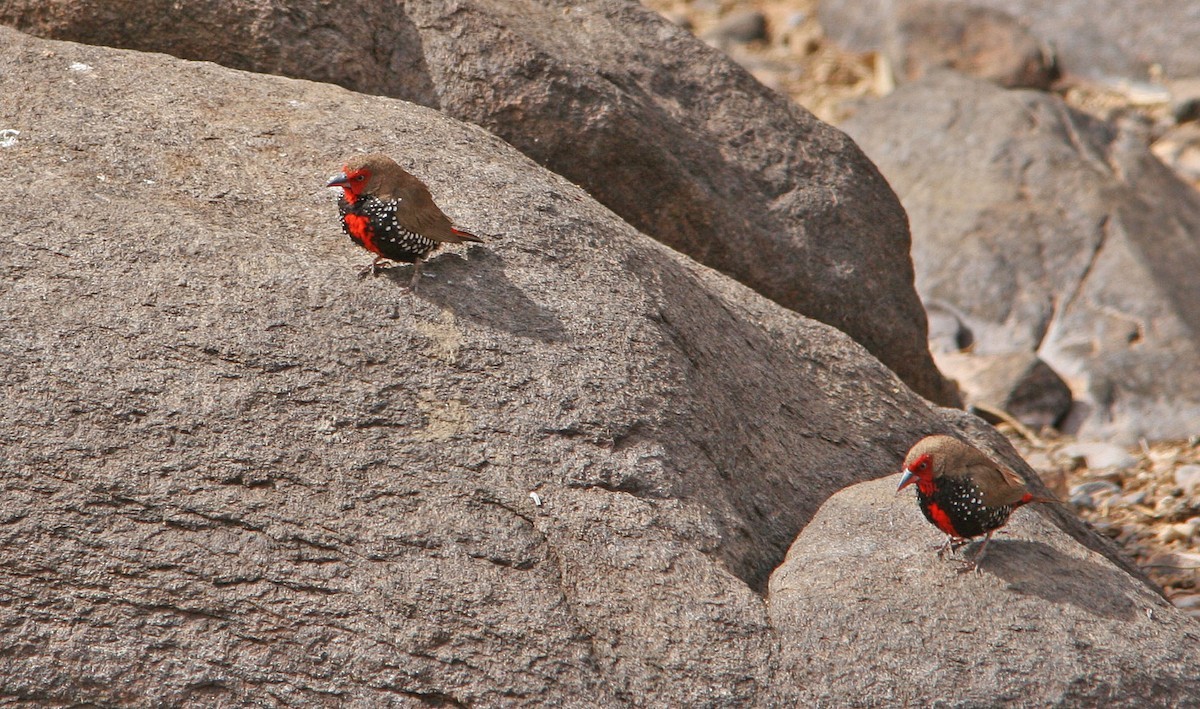Painted Finch
A species of Painted Finch Scientific name : Emblema pictum Genus : Painted Finch
Painted Finch, A species of Painted Finch
Botanical name: Emblema pictum
Genus: Painted Finch
Content
Description General Info
 Photo By Don Roberson
Photo By Don Roberson Description
The painted finch is a small passerine that is 10–12 cm in length and weighs around 11.5 g. Male painted finches have a red forehead and face that stand out in contrast to the black breast of individuals. A bright red patch in the middle of the breast is present, while the sides of the breast, belly and flanks are black with white spots. The tail and upper body and upper wing are a reddish-brown colour. The rump and uppertail coverts are also mostly red and highly conspicuous when the birds is in flight. Painted finches have a long, slender and pointed bill which in the male the upper mandible is mostly black with a red tip and the lower mandible is mostly red with light blue-grey patches on either side of the base. The Iris of males is a cream or off-white colour and the legs of males vary between a dark brown to pinkish colour. Females look similar to males, although the red colouration on the face is duller and is restricted to the lores, cheeks and around the eyes. The red patch present on the breast is also duller when compared to the males as are the underparts that are generally a duller brownish-black. The underparts on females though are more spotted. The bill of females is quite similar to males but usually with less red on upper mandible. The iris is also a cream or off-white colour and legs once again vary between dark brown to a pinkish colour. Juvenile painted finches are similar in appearance to females but their underparts are duller and browner. Juveniles lack the red colouration on their face and their bill is black which becomes paler and almost pinkish on the lower part. Juvenile's eyes are a grey-brown. 
Size
11 cm
Nest Placement
Ground
Feeding Habits
Painted Finch primarily consumes grass seeds, particularly from spinifex, occasionally eating fruit and grass. This bird forages on the ground, adeptly hopping and bouncing to find seeds. Although captive painted Finch may eat flying termites and aphids, insect consumption in the wild is unobserved.
Habitat
Painted Finch primarily dwells in arid and semi-arid regions where their habitat includes harsh stone deserts, gorges, and rocky hills interspersed with scrubby acacia thickets and spinifex grasslands. These birds tend to be found in proximity to water sources, and their presence extends deep into dry inland areas, where they can also inhabit orchards, provided that water is accessible.
Dite type
Herbivorous
General Info
Feeding Habits
Bird food type
Behavior
Painted finches usually occur in pairs and small flocks, however larger flocks of up to 100 individuals have been seen when congregating around water sources. These large flocks may contain other species of finches and honeyeaters. Painted finches are generally less vocal than other Australian grassfinches, however its calls are among the loudest and harshest of this species group. Its contact calls have been described as sounding like ‘trut, chek-chek’ or ‘ced up, cheddy-up’. When alone, males often make a loud wheezing and chattering song, females make a rattling call in response to danger near the nest. 
Distribution Area
The painted finch is found in arid and semi-arid zones, in rocky areas with a ground cover of spinifex grass. The painted finch can be found in Western Australia, Northern Australia, Queensland and South Australia In 2007 and 2008 large influxes of painted finches entered into western New South Wales. These individuals have since been recorded breeding and a resident population is now thought to have been established. 

 Photo By Don Roberson
Photo By Don Roberson Scientific Classification
Phylum
Chordates Class
Birds Order
Perching birds Family
Estrildid finches Genus
Painted Finch Species
Painted Finch